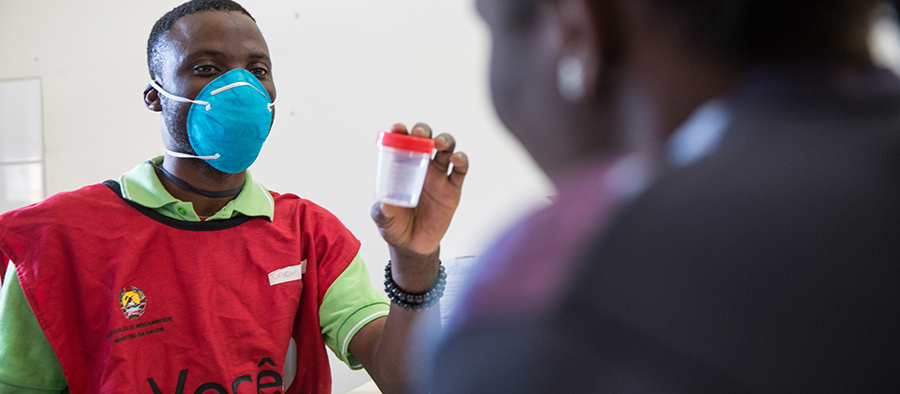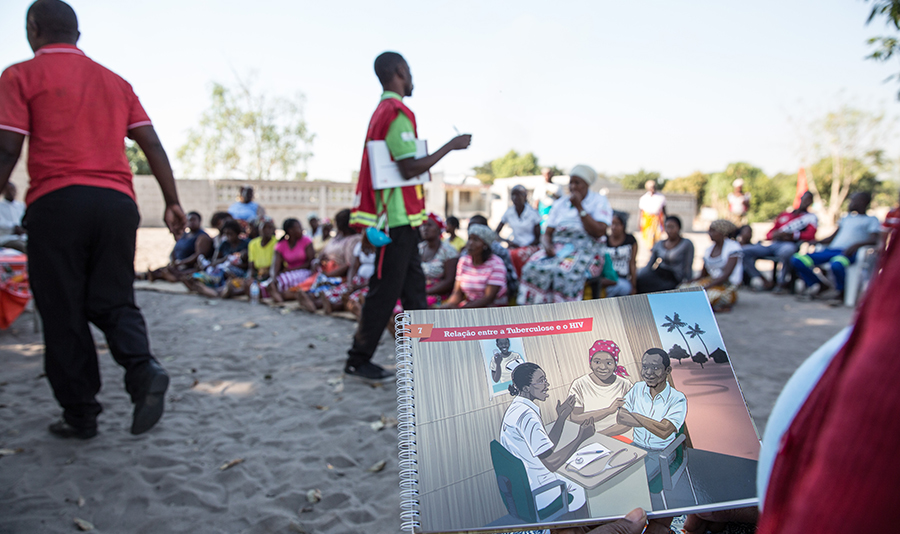CDC and Mozambique Work to Control Tuberculosis
Summary
- Mozambique is among the 14 countries most affected by TB in the world.
- In Mozambique, TB has a particularly high incidence among people living with HIV.
- Combined services for TB and HIV patients is a treatment model implemented by CDC, the Mozambique Ministry of Health (MOH) and partners.
- Innovative programs, like Cough Officers, improve case identification and reduce risk of TB transmission in health facilities.
Mozambique is one of the countries most affected by tuberculosis (TB) in the world. The US Centers for Disease Control and Prevention (CDC) and national health authorities aim to control TB by the year 2030.
Annually, the country averages 11,000 TB-related deaths and the infectious disease affects 361 per 100,000 people, according to 2019 data from the World Health Organization (WHO) and the Ministry of Health of Mozambique (MOH). Combined with a HIV epidemic that affects 13% of the country’s adult population, the high TB prevalence rate puts Mozambique among the 14 countries most affected by TB. High TB incidence rates are also associated with poverty, illiteracy, and low medical provider-to-patient ratios.

Mozambique is among the 14 countries most affected by TB in the world. TB education activities help Mozambican communities recognize early symptoms of the disease. Photo by Ricardo Franco/CDC.
In Mozambique, TB has a particularly high incidence among people living with HIV (PLHIV), with an estimated 50% of TB-related deaths occurring among this population. The interrelated epidemics require a combined public health approach. One focused on TB early diagnosis, treatment of positive cases, and provision of preventive TB therapy for PLHIV who have not yet developed the disease. Even though CDC work focuses on TB control among PLHIV, the efforts contribute to the national TB response.
For about 10 years, with funding from the U.S. President’s Emergency Plan for AIDS Relief (PEPFAR), CDC has provided technical and financial assistance to MOH’s National Tuberculosis Control Program. Through its clinical partners, CDC improves the provision of TB prevention, diagnosis, and treatment services. CDC also supports the network of reference laboratories of the National Institute of Health (INS) that aid in TB diagnosis.
Improving service models
HIV infection increases a person’s chances of developing TB and for this reason, people who are HIV-positive should receive and complete preventive TB therapy. Those with a positive TB diagnosis with unknown HIV status should be tested for HIV. Facilitating access to these combined services is the goal of the one-stop model that CDC, partners and MOH implement. The model allows people who are co-infected with HIV and TB to receive care for both diseases in one consultation, facilitating earlier treatment initiation.
CDC partners work at community and health facility levels. In communities, community health workers organize educational sessions to increase knowledge of the two diseases. They offer screening services for suspected cases of infection. These efforts are complemented by dissemination of messages through community radio.
In health facilities, lay counselors collaborate with health professionals to ensure all suspected TB cases are assessed. They organize health lectures that patients can attend while waiting to be seen by a clinician. Improving people’s knowledge helps them better identify early TB symptoms.
Cough Officers
The need to improve case identification led to the creation of the “Cough Officers” program in 2016. Early symptoms of TB may include a bad cough that lasts three weeks as well as coughing blood. Cough officers are trained to recognize possible TB cases. Patients visiting health services may think the coughing they are experiencing is associated with another disease, making it difficult to be diagnosed. The Cough Officers program has improved case identification, reducing the risk of TB transmission in health facilities. Case identification accelerates the initiation of TB treatment contact tracing, especially at the family level.

The Cough Officers program is contributing to TB case identification improvements in Mozambique. Photo by Ricardo Franco/CDC.
CDC-supported initiatives to improve models of care are yielding promising results for the TB response. Over the past two years, the treatment dropout rate reduced to 4% and the number of TB-associated deaths by about 14 percentage points, MOH data shows. Additionally, these interventions help the country achieve the TB diagnostic targets set by the WHO (90% of cases annually). Mozambique has a case identification rate of 88%, according to the 2020 National TB Prevalence Survey.
CDC and partners have implemented innovative services for TB patients. Including a new medicine regimen, that can be completed in just three months. The previous regimen lasted six months. The announcement of the new drug was celebrated on the 2021 World Tuberculosis Day, when the United States signaled its commitment to continue supporting Mozambique’s HIV/TB response with investments of about $18 million.
Strengthening laboratory and transportation capacity
Mozambique has two regional laboratories and a national reference laboratory for TB managed by INS. Their main objective is to support specialized diagnosis of TB, including multidrug-resistant (MDR-TB) and extensively drug-resistant (XDR-TB).
CDC supports INS with the implementation of new technologies, the training of laboratory technicians, and equipment maintenance. In the past, CDC contributed to safety and quality improvement of laboratories through the national Strengthening Laboratory Management Toward Accreditation (SLMTA) program, locally known as FOGELA. Through FOGELA, in 2015, the national laboratory achieved ISO (International Organization for Standardization) accreditation that certifies the provision of quality services. In 2020, a regional laboratory was also accredited. CDC also supported INS in the external quality assessment component of Xpert MTB/Rif (GeneXpert) testing, which enhanced the ability to provide capacity and flexibility in diagnosing TB and drug resistance.

CDC supports Mozambique laboratory capacity for TB diagnosis. Photo by Ricardo Franco/CDC.
Recently, CDC supported INS and the Provincial Health Directorates to develop a digital platform for monitoring external quality assessments (AEQ) of TB microscopy, called “Re-Blind Observation of Tuberculosis Microscopy (RC-TB).” This helps evaluate the quality of laboratories for corrective actions.
Since transportation of samples from collection sites to laboratories can be a challenge, PEPFAR funds an integrated sample referencing system for HIV and TB services (specifically for CD4, viral load, and TB tests). This system works with private transport companies to mobilize samples from any health facility to the existing reference laboratories.
Prevention is the best therapy
To improve the acceptance of preventive TB therapy and reduce the number of new TB cases, CDC, Friends in Global Health, and MOH are developing a health communication campaign. Activities include interpersonal communication, mass media interventions, and training of lay TB counselors.

Interpersonal communication will be a key activity of a new TB campaign that aims to improve the acceptance of preventive TB therapy and reduce the number of new cases. Photo by Ricardo Franco/CDC.
This initiative will complement other activities to improve the ability to health professionals and community health workers to provide appropriate information on TB prevention, diagnosis, and treatment. Community, religious leaders, and traditional medicine practitioners will be involved to increase acceptance in families.